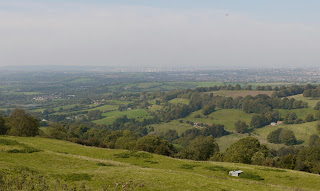Looking back towards Cold Ashton
We started the Cotswold Way in April last year, and today we finally embarked on the last leg. We picked up the route at Cold Ashton and headed south west along a long through fields, slowly descending. After Liliput Farm we gradually climbed back up again to reach the site of the civil war battle of Lansdown, fought in July 1643. A series of plaques describe the evolution of the battle. It seems that, just as often happened in the American civil war, the two generals had been personal friends.
Near to one of the plaques was this stone image of a looting soldier, copied from a 17th century print. There are other similar images, which mark the battlefield way, beside the other plaques. Well done to Bath and North East Somerset Council.
A little further on was a monument to Sir Bevil Grenville. It was erected in 1720. The forward-facing side of the monument is in poor condition, but it looks well from the side.
Sir Bevil was a royalist and the monument commemorates his heroism in the battle - in which he died - and that of his Cornish pikemen. Apparently his men then refused to fight for any other officer and went home, carrying their leader's body.
A bit further on, at Hanging Hill, we started to get great views down towards Bristol to the west.
It was was designed by Henry Goodridge and completed in 1827 for William Beckford (1760-1844). He used the tower as both a library and a retreat, located at the end of pleasure gardens called Beckford's Ride which ran from his house in Lansdown Crescent. Beckford previously had built the massive gothic revival house of Fonthill (architect James Wyatt), whose enormous spire collapsed soon after it was completed. Beckford had, wisely as it turned out, already sold it by then.
The route now passed behind Bath Racecourse and we could at last discover the source of the loud tannoy announcements we had been hearing for some time. We went past the Racecourse on the way home and established that the event concerned Agility, but of what we could not discover.
We walked through Weston and made an unwelcome climb to reach Summerhill Road, for the final descent into Bath from Sion Hill. We skirted the Royal Victoria Park and walked beneath the Royal Cresent, where many people were sunbathing on the grass in the surprising October heat.
Conditions: very hot, about 27 degrees. The hottest October day since records began 101 years ago.
Distance: 10 miles.
Map: Explorer 155 (Bristol and Bath.







No comments:
Post a Comment